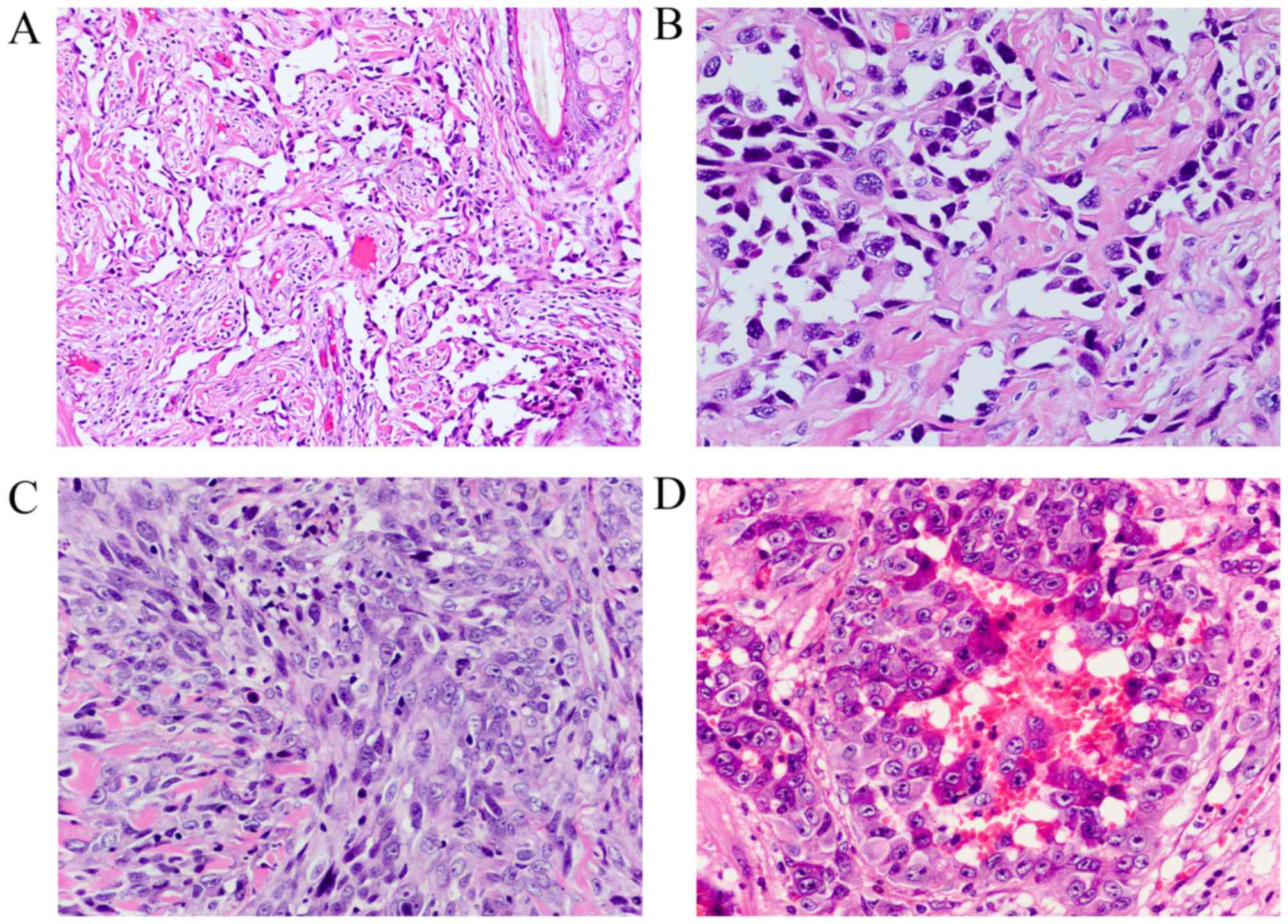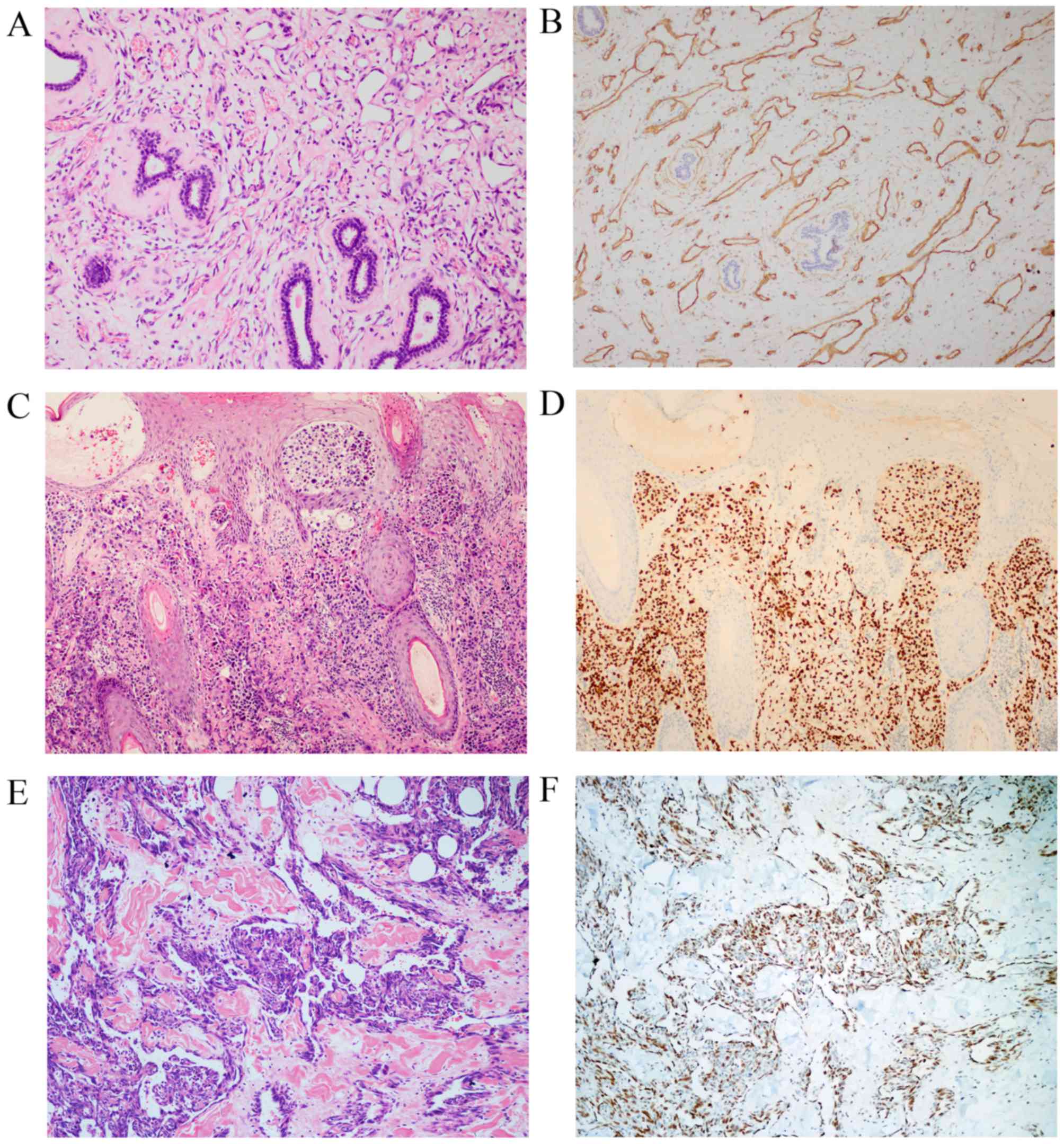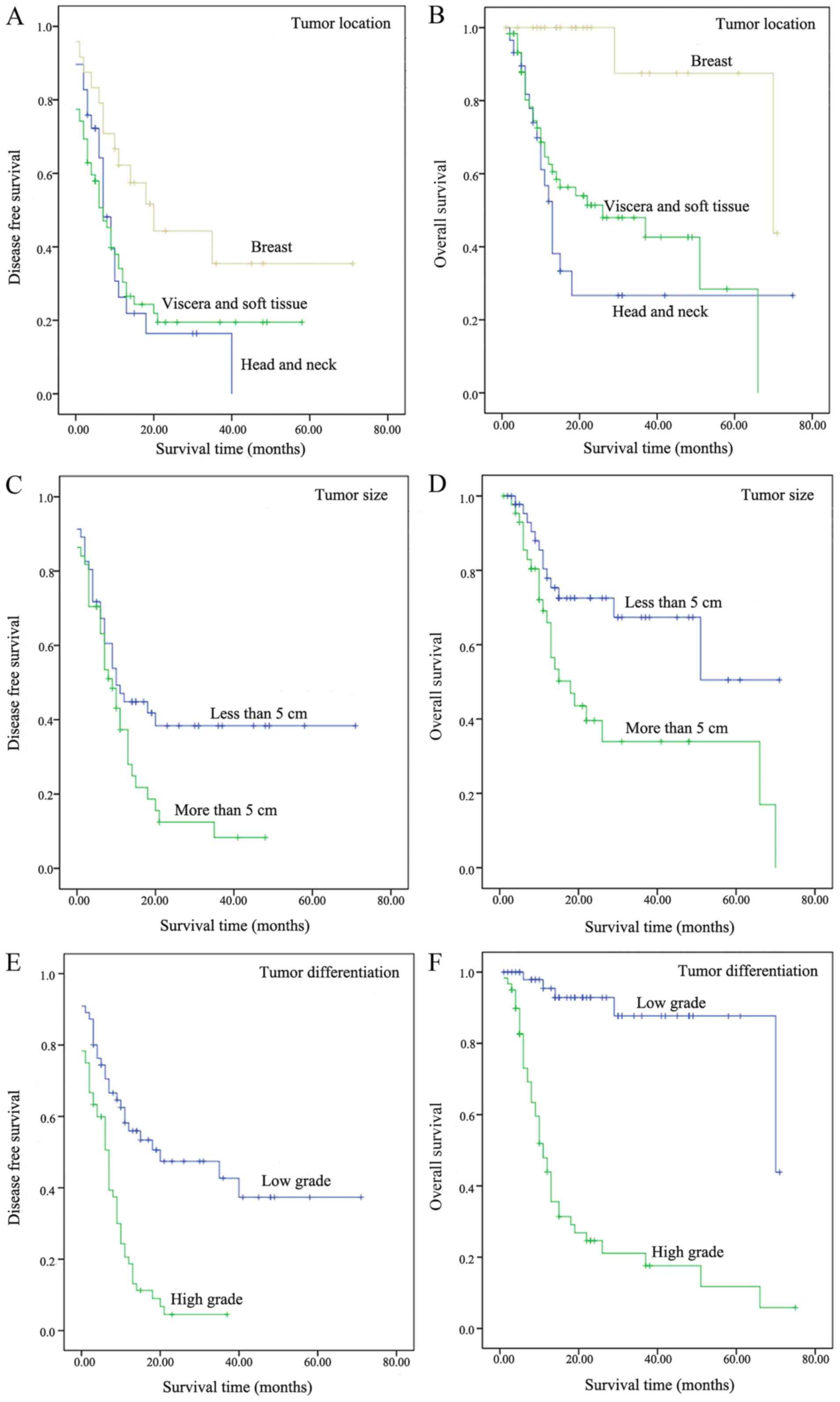|
1
|
Rouhani P, Fletcher CD, Devesa SS and Toro
JR: Cutaneous soft tissue sarcoma incidence patterns in the U.S.:
An analysis of 12,114 cases. Cancer. 113:616–627. 2008. View Article : Google Scholar : PubMed/NCBI
|
|
2
|
Toro JR, Travis LB, Wu HJ, Zhu K, Fletcher
CD and Devesa SS: Incidence patterns of soft tissue sarcomas,
regardless of primary site, in the surveillance, epidemiology and
end results program, 1978–2001: An analysis of 26,758 cases. Int J
Cancer. 119:2922–2930. 2006. View Article : Google Scholar : PubMed/NCBI
|
|
3
|
Fayette J, Martin E, Piperno-Neumann S, Le
Cesne A, Robert C, Bonvalot S, Ranchère D, Pouillart P, Coindre JM
and Blay JY: Angiosarcomas, a heterogeneous group of sarcomas with
specific behavior depending on primary site: a retrospective study
of 161 cases. Ann Oncol. 18:2030–2036. 2007. View Article : Google Scholar : PubMed/NCBI
|
|
4
|
Fury MG, Antonescu CR, Van Zee KJ, Brennan
MF and Maki RG: A 14-year retrospective review of angiosarcoma:
Clinical characteristics, prognostic factors, and treatment
outcomes with surgery and chemotherapy. Cancer J. 11:241–247. 2005.
View Article : Google Scholar : PubMed/NCBI
|
|
5
|
Fletcher CDM, Bridge JA, Hogendoorn PCW
and Mertens F: WHO Classification of Tumours of Soft Tissue and
Bone. 4th. IARC Press; Lyon: pp. 562013
|
|
6
|
Farid M, Ong WS, Lee MJ, Jeevan R, Ho ZC,
Sairi AN, Soh LT, Poon D, Teh J, Chin F, et al: Cutaneous versus
non-cutaneous angiosarcoma: Clinicopathologic features and
treatment outcomes in 60 patients at a single Asian cancer centre.
Oncology. 85:182–190. 2013. View Article : Google Scholar : PubMed/NCBI
|
|
7
|
Mark RJ, Poen JC, Tran LM, Fu YS and
Juillard GF: Angiosarcoma. A report of 67 patients and a review of
the literature. Cancer. 77:2400–2406. 1996. View Article : Google Scholar : PubMed/NCBI
|
|
8
|
Abraham JA, Hornicek FJ, Kaufman AM,
Harmon DC, Springfield DS, Raskin KA, Mankin HJ, Kirsch DG,
Rosenberg AE, Nielsen GP, et al: Treatment and outcome of 82
patients with angiosarcoma. Ann Surg Oncol. 14:1953–1967. 2007.
View Article : Google Scholar : PubMed/NCBI
|
|
9
|
Naka N, Ohsawa M, Tomita Y, Kanno H,
Uchida A and Aozasa K: Angiosarcoma in Japan. A review of 99 cases.
Cancer. 75:989–996. 1995. View Article : Google Scholar : PubMed/NCBI
|
|
10
|
Lahat G, Dhuka AR, Lahat S, Smith KD,
Pollock RE, Hunt KK, Ravi V, Lazar AJ and Lev D: Outcome of locally
recurrent and metastatic angiosarcoma. Ann Surg Oncol.
16:2502–2509. 2009. View Article : Google Scholar : PubMed/NCBI
|
|
11
|
Kakegawa S, Kawashima O, Ibe T, Ujita M,
Iwashina M, Nakano T and Shimizu K: A case of primary angiosarcoma
of the lung presenting as a hemorrhagic bronchial tumor. Ann Thorac
Cardiovasc Surg. 18:347–351. 2012. View Article : Google Scholar : PubMed/NCBI
|
|
12
|
Letsa I, Benson C, Al-Muderis O and Judson
I: Angiosarcoma of the face and scalp: Effective systemic treatment
in the older patient. J Geriatr Oncol. 5:276–280. 2014. View Article : Google Scholar : PubMed/NCBI
|
|
13
|
Bae SY, Choi MY, Cho DH, Lee JE, Nam SJ
and Yang JH: Large clinical experience of primary angiosarcoma of
the breast in a single Korean medical institute. World J Surg.
35:2417–2421. 2011. View Article : Google Scholar : PubMed/NCBI
|
|
14
|
Meis-Kindblom JM and Kindblom LG:
Angiosarcoma of soft tissue: A study of 80 cases. Am J Surg Pathol.
22:683–697. 1998. View Article : Google Scholar : PubMed/NCBI
|
|
15
|
Zheng YW, Zhang XW, Zhang JL, Hui ZZ, Du
WJ, Li RM and Ren XB: Primary hepatic angiosarcoma and potential
treatment options. J Gastroenterol Hepatol. 29:906–911. 2014.
View Article : Google Scholar : PubMed/NCBI
|
|
16
|
Vorburger SA, Xing Y, Hunt KK, Lakin GE,
Benjamin RS, Feig BW, Pisters PW, Ballo MT, Chen L, Trent J III, et
al: Angiosarcoma of the breast. Cancer. 104:2682–2688. 2005.
View Article : Google Scholar : PubMed/NCBI
|
|
17
|
Hodgson NC, Bowen-Wells C, Moffat F,
Franceschi D and Avisar E: Angiosarcomas of the breast: A review of
70 cases. Am J Clin Oncol. 30:570–573. 2007. View Article : Google Scholar : PubMed/NCBI
|
|
18
|
Biswas T, Tang P, Muhs A and Ling M:
Angiosarcoma of the breast: A rare clinicopathological entity. Am J
Clin Oncol. 32:582–586. 2009. View Article : Google Scholar : PubMed/NCBI
|
|
19
|
Monroe AT, Feigenberg SJ and Mendenhall
NP: Angiosarcoma after breast-conserving therapy. Cancer.
97:1832–1840. 2003. View Article : Google Scholar : PubMed/NCBI
|
|
20
|
Fraga-Guedes C, Gobbi H, Mastropasqua MG,
Botteri E, Luini A and Viale G: Primary and secondary angiosarcomas
of the breast: A single institution experience. Breast Cancer Res
Treat. 132:1081–1088. 2012. View Article : Google Scholar : PubMed/NCBI
|
|
21
|
Rosen PP, Kimmel M and Ernsberger D:
Mammary angiosarcoma. The prognostic significance of tumor
differentiation. Cancer. 62:2145–2151. 1988. View Article : Google Scholar : PubMed/NCBI
|
|
22
|
Van Glabbeke M, van Oosterom AT,
Oosterhuis JW, Mouridsen H, Crowther D, Somers R, Verweij J,
Santoro A, Buesa J and Tursz T: Prognostic factors for the outcome
of chemotherapy in advanced soft tissue sarcoma: An analysis of
2,185 patients treated with anthracycline-containing first-line
regimens-a European Organization for Research and Treatment of
Cancer Soft Tissue and Bone Sarcoma Group Study. J Clin Oncol.
17:150–157. 1999. View Article : Google Scholar : PubMed/NCBI
|
|
23
|
Pawlik TM, Paulino AF, McGinn CJ, Baker
LH, Cohen DS, Morris JS, Rees R and Sondak VK: Cutaneous
angiosarcoma of the scalp: A multidisciplinary approach. Cancer.
98:1716–1726. 2003. View Article : Google Scholar : PubMed/NCBI
|
|
24
|
Sher T, Hennessy BT, Valero V, Broglio K,
Woodward WA, Trent J, Hunt KK, Hortobagyi GN and Gonzalez-Angulo
AM: Primary angiosarcomas of the breast. Cancer. 110:173–178. 2007.
View Article : Google Scholar : PubMed/NCBI
|
|
25
|
Karpeh MS Jr, Caldwell C, Gaynor JJ, Hajdu
SI and Brennan MF: Vascular soft-tissue sarcomas. An analysis of
tumor-related mortality. Arch Surg. 126:1474–1481. 1991. View Article : Google Scholar : PubMed/NCBI
|
|
26
|
Naka N, Ohsawa M, Tomita Y, Kanno H,
Uchida A, Myoui A and Aozasa K: Prognostic factors in angiosarcoma:
A multivariate analysis of 55 cases. J Surg Oncol. 61:170–176.
1996. View Article : Google Scholar : PubMed/NCBI
|
|
27
|
Stewart FW and Treves N: Lymphangiosarcoma
in postmastectomy lymphedema; a report of six cases in
elephantiasis chirurgica. Cancer. 1:64–81. 1948. View Article : Google Scholar : PubMed/NCBI
|
|
28
|
Huang J and Mackillop WJ: Increased risk
of soft tissue sarcoma after radiotherapy in women with breast
carcinoma. Cancer. 92:172–180. 2001. View Article : Google Scholar : PubMed/NCBI
|
|
29
|
Bosetti C, La Vecchia C, Lipworth L and
McLaughlin JK: Occupational exposure to vinyl chloride and cancer
risk: A review of the epidemiologic literature. Eur J Cancer Prev.
12:427–430. 2003. View Article : Google Scholar : PubMed/NCBI
|
|
30
|
Ron E: Cancer risks from medical
radiation. Health Phys. 85:47–59. 2003. View Article : Google Scholar : PubMed/NCBI
|
|
31
|
Ahmed I and Hamacher KL: Angiosarcoma in a
chronically immunosuppressed renal transplant recipient: Report of
a case and review of the literature. Am J Dermatopathol.
24:330–335. 2002. View Article : Google Scholar : PubMed/NCBI
|
|
32
|
Lucas DR: Angiosarcoma,
radiation-associated angiosarcoma, and atypical vascular lesion.
Arch Pathol Lab Med. 133:1804–1809. 2009.PubMed/NCBI
|
|
33
|
Perez MC, Padhya TA, Messina JL, Jackson
RS, Gonzalez RJ, Bui MM, Letson GD, Cruse CW, Lavey RS, Cheong D,
et al: Cutaneous angiosarcoma: A single-institution experience. Ann
Surg Oncol. 20:3391–3397. 2013. View Article : Google Scholar : PubMed/NCBI
|

















